Physical Address
304 North Cardinal St.
Dorchester Center, MA 02124
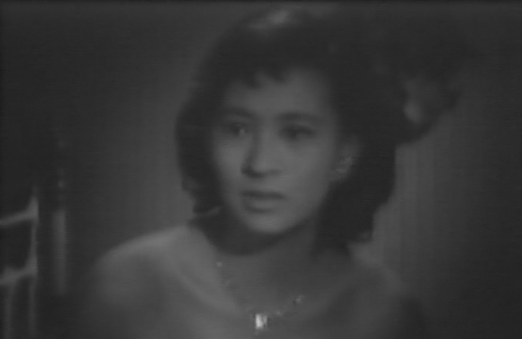
(Continued from page 2)
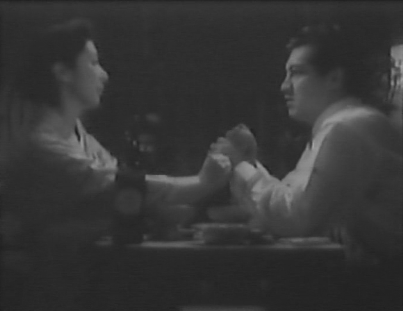
Seeing the film for the fourth time, I was struck by how prominently the characters’ hands convey their shifting relationships, a nice use by the filmmakers of visual means to advance the drama in this otherwise very dialogue-driven film. When Ihara and Nobuko dine in the Ginza after the concert they attend together, and she pours his beer for him, Ihara, with typical aggressiveness, seizes her hand in a brazen attempt to seduce her – but she’s having none of it. While he holds her hand in his and their eyes lock, she, unnoticed by him, lifts his still-lit cigarette from the ashtray and crushes it out on his hand, much to his surprise. (“I’m to be feared,” she says, smiling.)
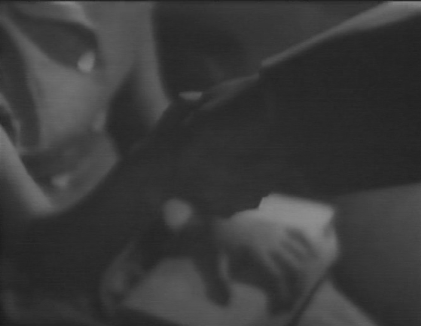
In a later scene, when Ihara accompanies Tamiko as far as Yokohama while on her trip to Kyoto, and is about to disembark, he casually shakes her hand: this time, for once, out of politeness and with no ulterior intent. But Tamiko, lost in her desire for him, refuses to let go of his hand, and he realizes that he has the young woman in his power. (They sleep together for the first time that night.)

During Tamiko’s return trip to Tokyo from Kyoto, Tamiko meets by chance her other suitor, Komatsu. They chat amiably for awhile until she falls asleep on the seat beside him. But when her hand innocently falls onto his lap, he carefully removes it – a foreshadowing of his later final rejection of her.
Nobuko emerges by default as the only sympathetic character in the narrative. The blogger for the Japanonfilm website has pointed out that a recurring theme in Japanese movies of the classic era (and later) is that “no good deed goes unpunished,” and that’s certainly true of poor Nobuko, who merely wants to do her duty as a stepmother to adult children that she can’t bring herself to love, and who absolutely loathe her.
Uchida’s decision to cast Tsukioka Yumeji in this role is curious: the character is repeatedly referred to as being forty years old, while Tsukioka was at that time only in her early thirties, and very youthful-looking at that. Nevertheless, the actress admirably captures the woman’s dignity, warmth, compassion and paradoxical toughness. When, in the scene described above, she crushes out the lit cigarette in Ihara’s hand, the gesture is meant to discourage her own desire as much as his.
Nobuko, attracted despite herself to Ihara, had at first encouraged Tamiko to marry the doctor because of his wealth and social position. However, she later tries, for the young woman’s own good, to discourage her involvement with him, an altruistic act that the shallow and selfish Tamiko interprets as the scheming of a ruthless rival.
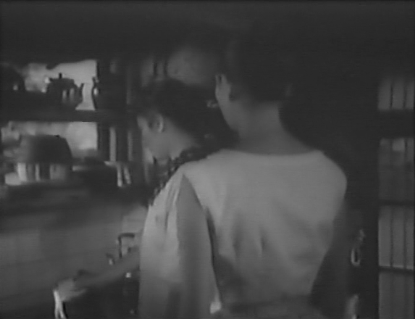
Nobuko in the kitchen receives from Tamiko a letter addressed to herself from Ihara, and Tamiko rudely demands that she open it and read it in front of her. The older woman unexpectedly tears the letter up unread, and burns the pieces in the flame of the kitchen stove. (The audience never does find out what was in the letter.) Nobuko is being cruel to be kind, but the narcissistic Tamiko, obsessed with Ihara, perceives only the cruelty, and this quarrel precipitates the final break between stepmother and stepdaughter.
Junjiro’s contempt for his stepmother, by contrast, is sly and subtle, couched in the language of “democratization.” When Nobuko asks Junjiro if he agrees with his sister that she, Nobuko, has become an “unsettling presence” in the siblings’ lives, he hypocritically replies that Nobuko can do as she pleases and that “we should respect each others’ freedoms and rights.” (He says this even as he schemes to deprive Nobuko of the land money to which she’s entitled.)
He would be a merely villainous rather than a tragic character if not for his destructive passion for his errant wife Keiko. Her surprising return to the household in the film’s final act seems to me unmotivated and unbalances the film’s narrative arc. Yet Junjiro’s painful obsession with her, which leads him to risk death by crawling out of his sickbed to be with her, is strangely moving, and stands in fascinating contrast to Ihara’s contempt for and indifference to his own (unseen) ex-wife.
It’s very surprising that Uchida and Yagi manage to evoke any sympathy at all for Tamiko, who’s cold, selfish and immature, and a thief to boot, as she brazenly and illegally withholds Nobuko’s part of their inheritance. Even her sincere affection and care for her sick brother is compromised when, after learning from him that he’s wasted the family fortune, including Nobuko’s share of it, through bad stock investments, she becomes so angry that she leaves him at the mercy of his illness – in effect killing him. Her grief at his subsequent death is thus compounded by guilt.
But the viewer can’t ultimately find satisfaction in Tamiko’s self-destruction, because she has lost, or is about to lose, literally everything: family, lover, wealth, even her own house, and one wonders what will become of her. (On the other hand, she still has her rich uncle and that chalet of his, so she’s not totally without options.) The film is ultimately a study of extreme perversity: Tamiko and Junjiro scorn the people who try to help them, like Nobuko, and vainly pursue people who despise and hurt them, like Ihara and Keiko.
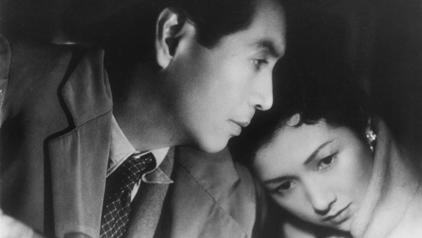
The visual look of the film is most unusual, perhaps unique for Uchida. The cinematography and the décor of this very dark film have the muted, somber quality of Naruse Mikio in his most fertile period, particularly of his classic Floating Clouds (Ukigumo), also released in 1955.
The music by Akutagawa Yasushi is also extremely unusual in being a series of baroque melodies, presumably composed for the film, played on the harpsichord, long before the use of harpsichord music for sinister or comic effect became a cliché of films and TV in the 1960s (e.g., The Prisoner, The Addams Family).1 And many critics have commented upon Uchida’s use of offscreen sounds – traffic, construction noises, fighter jets – to evoke a bustling modern world beyond the hothouse environment in which the drama plays out.
On the negative side, one of Uchida’s most admirable qualities as a moviemaker – his narrative concision – seemed to have temporarily deserted him. Quite a few short scenes have no dramatic point. Although my synopsis above may appear extremely detailed, about half a dozen scenes have been entirely omitted from it, or else condensed into a sentence or two. If those needless sequences had been eliminated, and the rest tightened up in the editing, the released film could easily have been at least fifteen minutes shorter, which would have greatly improved it. As it is, the film’s slightly more than two-hour running time feels much longer than it is.
And so, in 1955, Uchida Tomu released three vastly different films – A Bloody Spear at Mount Fuji, Twilight Saloon and this one – for three different studios. Although they were not equally successful artistically, each revealed different facets of his rich and complex talent. Despite being a man of late middle age in very poor health, the filmmaker, as if to compensate for his dozen years away from the director’s chair, had set himself the grueling challenge of completing three very ambitious films back-to-back, and had succeeded.
As far as is known to me, Uchida’s comeback was the most impressive of any director in the whole history of Japanese Cinema. The only comparable career resurrection is that of Kurosawa Akira, who, after a decade of heartbreaking failure and a well-publicized suicide attempt, released, in 1975, the Oscar-winning Dersu Uzala – ironically, a Soviet production in the Russian language. But Kurosawa, of course, had the enormous advantage of a huge international audience for his work, which Uchida didn’t have… and still doesn’t.
Uchida’s attempt at a Naruse-like woman’s melodrama is fascinating, but the narrative is slow-moving, somewhat unfocused and not completely plausible, though the film contains excellent performances, particularly by Tsukioka Yumeji and Mikuni Rentarō.
Midnight Eye [Jasper Sharp]
Senses of Cinema [Alexander Jacoby]
[…] A Hole of My Own Making (Jibun no ana no nakade; 自分の穴の中で), 1955 […]
[…] A Hole of My Own Making (Jibun no ana no nakade; 自分の穴の中で), 1955 […]
[…] A Hole of My Own Making (Jibun no ana no nakade; 自分の穴の中で), 1955 […]
[…] A Hole of My Own Making (Jibun no ana no nakade; 自分の穴の中で), 1955 […]
Fantastic blog! Do you have any helpful hints for aspiring
writers? I’m hoping to start my own website soon but I’m a little lost on everything.
Would you propose starting with a free platform
like WordPress or go for a paid option? There are so many
choices out there that I’m totally overwhelmed ..
Any recommendations? Kudos!
Thanks for your kind comments. Creating a blog is just a matter of learning by doing. I had to learn everything from scratch. It’s mainly a matter of figuring out what you want on your blog and how to organize it. I’m on free WordPress, but hosted by a paid service. This is working out so far, though it’s become expensive recently.